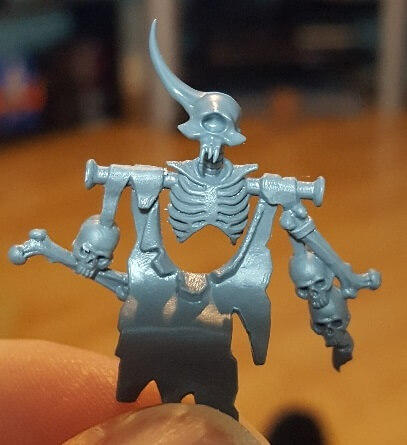Well the festive season came and went in a blur. Sadly a combination of having to work between Christmas and New Year and various family commitments has meant two “missed” blog Sundays and a reduction in general painting time, but such things happen. In an effort to rectify this I will be doing a mid-week post on my 52 Week Challenge 🙂
Before Christmas I decided to have a small detour from my Imperial Knights and grabbed the Terminators from my box of Space Hulk. As much as I enjoy painting red (and green) I don’t often paint it with my current choice of armies and miniatures. I’ve also been watching the Painting Buddha Ultramarine videos recently (I’m a PB backer and Patreon so get the HD videos) and this has inspired me to try and paint using blends and pushing the shadows more than I have done on my Space Wolves army.
I’m very happy with the result and I feel it’s improved my use of my wet palette and getting colours right. The picture doesn’t quite show the depth of colour I’ve managed to achieve so far, the second miniature is actually better! I shall now veer off at a tangent on the subject of techniques…
When I started painting some 25+ years ago, miniature painting was a very different affair. Firstly the range of Acrylic paints was pretty much limited to Citadel paints (using Enamel was common), the internet wasn’t yet a consumer platform filled with used painting guides and easy access to products we now take for granted. Everything you had was gleaned through White Dwarf or practise. Over the years this has completely changed, my paint collection has at least six different manufacturers and well over 200 different colours, including thick paints, thin paints, metallics, GW dry, inks, washes and airbrush paints. The biggest change has however snuck in whilst nobody was looking and that’s the usage of washes/shades to provide the shading on a miniature. In fact Games Workshop’s whole paint range is built with the concept of base coat, wash, highlight.
It wasn’t until I watched the Painting Buddha video where Ben doesn’t touch a pre-made shade that I realised that I had ended up in that very manufactured trend of using washes/shades for everything I was doing. I also have become a “buy the colour” painter rather than mixing paints to get the exact colour I want.
Now I’m not saying that this is a bad thing, far from it. Paints available in every colour under the sun and washes provides a very solid foundation for painting up a very decent quality army – there is genuinely no excuse to field an entirely unpainted army in a game with the comment of “I’m not very good at painting” – grab the Games Workshop painting guide or view the videos online by Duncan at Games Workshop and stop making excuses.
What is a bad thing though is that I believe it pushes you down a little dead end when it comes to improving yourself. Washes for shading do not give you as much control as a shadow colour you’ve mixed yourself. The shadow on the “lit” side shouldn’t be as dark as the shadow on the “unlit” side and although you can layer up pre-made washes, sometimes a tiny hint of a dark colour (purple, brown etc) can enrich an effect.
So now I’ve waffled on will I be changing how I paint things?
Mostly no, but some yes. The base/wash/highlight technique (and it is a technique not a cheat) does have a very important place within the hobby. It is hands down, the optimum method for painting armies for gaming. When you’re looking at miniatures that are 2+ feet away it doesn’t normally make any difference between a miniature that has been “manufactured” or one that has taken 250 hours with carefully painted shadows and highlights. Personally for me I’ve reminded myself that I enjoy painting the odd miniature using the techniques I started out with.

